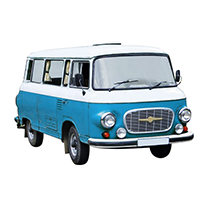
Catalog / Barkas
How much do new and used Barkas cars cost?
Barkas is a name that may be unfamiliar to many, but it holds a special place in the automotive history of the former German Democratic Republic (GDR). Founded in 1958, Barkas became a key manufacturer of light commercial vehicles in East Germany.
The Barkas story begins with the B1000 model, which was developed from the earlier Framo V901/2 van. Production of the B1000 began at the plant in Karl-Marx-Stadt (now Chemnitz) and continued until 1991. This van became a real icon of the East German car industry, thanks to its reliability and versatility.
Interestingly, the name ‘Barkas’ comes from the German word ‘Barke’, which means ‘barca’ or small vessel. This name was chosen to emphasise the payload and practicality of the cars.
In 1989, shortly before the fall of the Berlin Wall, an updated version was presented - B1000-1. It received a more modern four-stroke engine from Volkswagen, which significantly improved the performance of the vehicle. However, the production continued for a short time - only until 1991, when the plant was closed after the reunification of Germany.
During its existence, Barkas produced around 176,000 vehicles, making the B1000 one of the most mass-produced commercial vehicles in the GDR. These vans were used everywhere from the postal service to fire brigades.
Today, Barkas are not just a piece of automotive history, but also a collector's item. Many enthusiasts are restoring these vehicles, preserving the memory of an entire era. Barkas enthusiast clubs exist not only in Germany, but also in other European countries.
Interestingly, despite the cessation of production, spare parts for the Barkas B 1000 continued to be produced for several years after the factory closed, which testifies to the popularity and durability of these cars.
Barkas left a significant trace in the automotive culture of East Germany and today these cars are not just vehicles, but symbols of a whole era, reflecting the history and technological development of the GDR.

